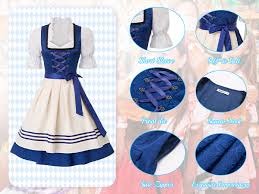The Dirndl Renaissance: Why This Traditional Dress is Making a Comeback

In recent years, traditional German and Austrian attire has experienced a remarkable revival, with the dirndl leading the charge. Once relegated to festive occasions and regional festivals, the dirndl—a distinctive, feminine dress featuring a fitted bodice, full skirt, and apron—is enjoying a renaissance, captivating the modern fashion scene with its rich heritage and charming appeal. This resurgence can be attributed to a blend of cultural pride, modern reinterpretations, and the influence of global fashion trends.
Historically, the dirndl emerged from the Alpine regions of Germany and Austria as a garment worn by women of all social classes. Initially designed as practical clothing for working-class women, the dirndl’s evolution into a symbol of regional identity and pride was solidified by its association with traditional festivals such as Oktoberfest. The dirndl’s design—characterized by its low-cut bodice, puffed sleeves, and gathered skirt—was both practical and visually appealing, making it a staple of rural life.
However, as the 20th century progressed, the dirndl became somewhat relegated to the realm of folklore and regional festivals. It was often seen as a relic of the past, worn primarily during celebrations like Oktoberfest or other cultural events. This shift in perception meant that the dirndl, along with its counterpart, Lederhosen (the traditional male attire featuring leather shorts), was not widely integrated into contemporary fashion.
In recent years, though, the dirndl has experienced a notable resurgence. This renaissance can be traced to several factors. First and foremost, there has been a growing trend towards celebrating and embracing cultural heritage. In a globalized world where traditional values and identities are often overshadowed by modernity, many people are rediscovering and taking pride in their cultural roots. The dirndl, with its rich history and distinctive style, has become a powerful symbol of this cultural revival.
Moreover, the dirndl’s comeback has been fueled by innovative designers and fashion houses who have reimagined this traditional garment for the modern era. Contemporary dirndls are not merely replicas of their historical predecessors but are instead characterized by creative adaptations and updates. Designers are experimenting with new fabrics, bolder colors, and unique patterns while still retaining the essential elements of the traditional dirndl. This fusion of tradition and modernity has allowed the dirndl to appeal to a younger audience who might otherwise view it as outdated or irrelevant.
The dirndl’s resurgence is also closely linked to the increased popularity of traditional festivals and events, such as Oktoberfest, which have gained international recognition. These festivals celebrate not just the traditional foods and drinks of the region but also the rich cultural attire associated with them. As people from around the world partake in these festivities, they are introduced to the dirndl and its significance, further fueling its global appeal.
Additionally, the dirndl’s return to fashion has been bolstered by the influence of celebrities and influencers who have embraced and showcased this traditional attire. By donning modernized versions of the dirndl on social media and at high-profile events, these public figures have helped to elevate the dirndl from a niche cultural garment to a prominent fashion statement. Their endorsement has made the dirndl more accessible and desirable to a broader audience, bridging the gap between tradition and contemporary style.
In contrast to the dirndl, Lederhosen—traditional male attire—has also seen its share of modern adaptation but hasn’t experienced the same level of widespread revival. While Lederhosen remains a popular choice for men attending Oktoberfest and other cultural events, its influence on everyday fashion is not as pronounced as that of the dirndl. Nevertheless, both garments share a deep cultural significance and continue to symbolize regional pride and heritage.
The dirndl’s comeback is not merely a fleeting trend but a testament to the enduring appeal of cultural heritage and the ability of traditional garments to adapt to contemporary tastes. As the dirndl continues to evolve and inspire modern fashion, it serves as a reminder of the importance of preserving and celebrating cultural traditions while embracing the future.
conclusion
the dirndl renaissance is a multifaceted phenomenon driven by a renewed appreciation for cultural heritage, innovative fashion design, and global festival culture. As it continues to captivate and inspire, the dirndl stands as a vibrant symbol of tradition meeting modernity, demonstrating that even the most historical garments can find new life in the contemporary world.





